Explorez Hiroshima - Voyage au Japon, Asie
Hiroshima, une ville dynamique située sur l'île de Honshu à l'ouest du Japon, est réputée pour son histoire profonde et ses attractions époustouflantes. Porte d'entrée vers la compréhension du passé complexe du Japon et de son avenir plein d'espoir, Hiroshima offre aux voyageurs un mélange unique de perspectives historiques, de richesse culturelle et de modernité. Cette ville animée, qui a survécu à l'un des moments les plus sombres de l'histoire, s'est transformée en un symbole de paix et de résilience, attirant des visiteurs du monde entier.
Population : Environ 1,2 million d'habitants en 2019.
Économie : Exemple de restauration urbaine et de croissance, Hiroshima est aujourd'hui l'un des plus grands pôles économiques et d'investissement étranger au Japon.
Monuments : Parc du Mémorial de la Paix d’Hiroshima, sanctuaire d’Itsukushima et château d’Hiroshima.
Japan
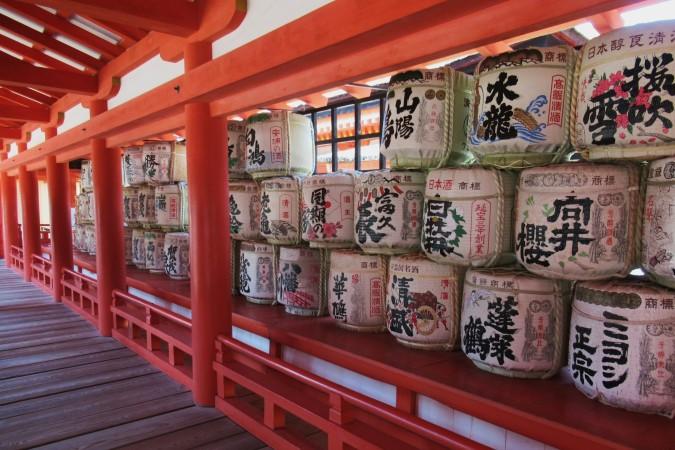
Aperçu de Hiroshima
Histoire et Influence Culturelle
L'histoire de Hiroshima est profondément marquée par les événements du 6 août 1945, lorsque la ville fut la cible du premier bombardement atomique au monde. Cet événement tragique a laissé une empreinte indélébile sur la ville et ses habitants. Aujourd'hui, Hiroshima est un puissant symbole de paix et de guérison. Le Parc du Mémorial de la Paix d’Hiroshima, site classé au patrimoine mondial de l’UNESCO, commémore ce moment historique crucial.
Au-delà de son passé historique, Hiroshima est un centre culturel dynamique. La ville célèbre une variété de coutumes et d'événements qui mettent en valeur son riche patrimoine japonais. L'influence de la culture japonaise se reflète dans l'architecture, l'art et la vie quotidienne de Hiroshima, offrant aux visiteurs l'occasion de découvrir des traditions japonaises authentiques.
Interaction avec les Habitants
Hiroshima, située dans l'ouest du Japon, compte environ 1,2 million d'habitants. Centre urbain animé et capitale de la préfecture de Hiroshima, elle est réputée pour son importance historique, son patrimoine culturel et ses infrastructures modernes. La diversité de sa population contribue à son atmosphère dynamique, où tradition et modernité se rencontrent harmonieusement.
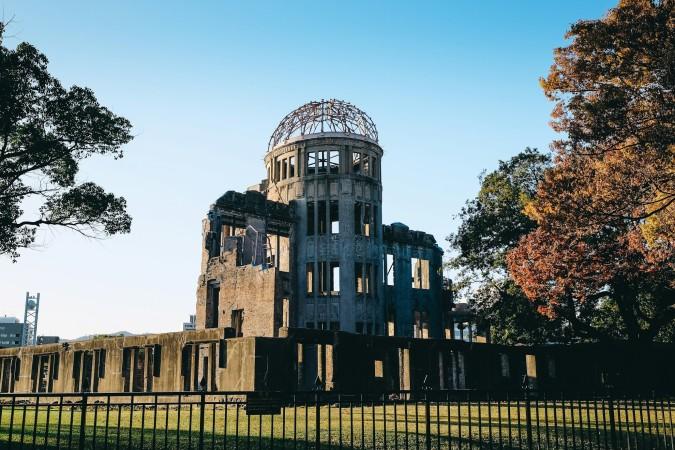
Parc du Mémorial de la Paix de Hiroshima - © Rap Dela Rea
Principales Attractions à Hiroshima
Parc du Mémorial de la Paix d’Hiroshima
Le Parc du Mémorial de la Paix d’Hiroshima est une visite incontournable pour quiconque se rend dans la ville. Conçu par l’architecte Kenzo Tange, ce vaste parc abrite plusieurs sites emblématiques, notamment le Dôme de la Bombe Atomique et le Musée du Mémorial de la Paix. Son cadre paisible et ses expositions émouvantes offrent un espace de réflexion sur le passé de la ville et son engagement envers la paix.
Sanctuaire d’Itsukushima (Miyajima)
Une courte traversée en ferry depuis Hiroshima vous mène à l'île de Miyajima, où se trouve le célèbre sanctuaire d’Itsukushima. Ce temple shinto, réputé pour son torii "flottant", est l’un des sites les plus photographiés du Japon. À marée haute, le torii semble flotter sur la mer, offrant des vues à couper le souffle. Entouré de forêts luxuriantes et d’eaux tranquilles, le sanctuaire offre une évasion sereine loin de l'agitation de la ville.
Château d’Hiroshima
Le château d’Hiroshima, souvent appelé Château des Carpes, plonge les visiteurs dans l’histoire féodale du Japon. Sa structure imposante, reconstruite après sa destruction pendant la Seconde Guerre mondiale, abrite un musée exposant des artefacts de l'époque des samouraïs. Depuis le dernier étage du château, les visiteurs peuvent profiter d’une vue panoramique sur la ville, ce qui en fait un lieu idéal pour les passionnés d’histoire et les photographes.
Jardin Shukkeien
Pour une retraite paisible au cœur de la ville, le jardin Shukkeien est un superbe exemple du paysage traditionnel japonais. Créé à l'époque d’Edo, ce jardin ancien offre des promenades sinueuses, des étangs paisibles et des jardins soigneusement entretenus. C’est l’endroit idéal pour une promenade tranquille ou pour découvrir l'atmosphère authentique d’un jardin japonais traditionnel.
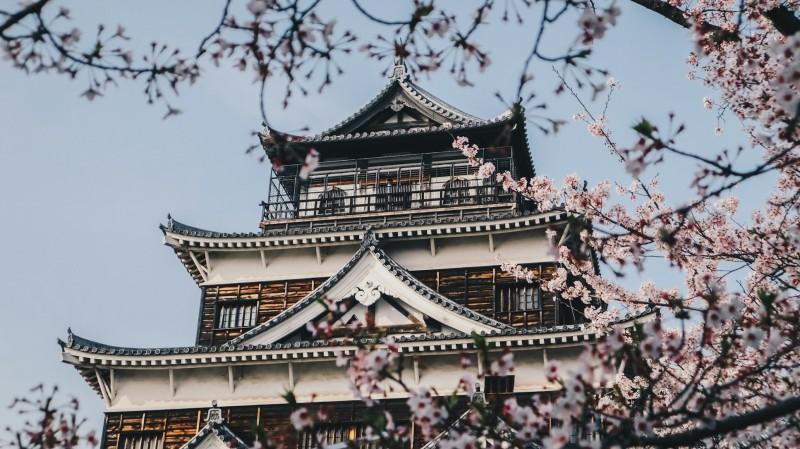
Château de Hiroshima - © Kenshi Kingami
Plats Incontournables à Hiroshima
- Okonomiyaki : L'okonomiyaki de Hiroshima est une crêpe salée composée de couches de chou, de viande, de fruits de mer et nappée d'une sauce acidulée. Plat local apprécié, il est préparé sur une plaque chauffante et peut être personnalisé selon vos goûts.
- Tsukemen : Le tsukemen est un plat de nouilles froides trempées dans un bouillon chaud et savoureux. Cette spécialité offre un contraste rafraîchissant et se déguste souvent avec une variété de garnitures.
- Soba et Udon : Goûtez aux soba (nouilles de sarrasin) et aux udon (nouilles épaisses de blé) à Hiroshima. Servies dans des bouillons ou sautées, ces nouilles traditionnelles sont réconfortantes et riches en saveurs.
- Goya Champuru à la Hiroshima : Le Goya Champuru est un sauté de melon amer (goya), tofu, porc et légumes. Son goût amer distinctif combiné à des ingrédients savoureux en fait une spécialité unique de Hiroshima.
- Sushi à la Hiroshima : Le sushi de Hiroshima met souvent à l'honneur des poissons et fruits de mer frais de la région. Essayez le Hamaguri sushi (sushi aux palourdes) ou l'Anago sushi (sushi à l'anguille de mer) pour découvrir les saveurs côtières de la ville.
- Kaki Furai : Les Kaki Furai sont des huîtres panées et frites, offrant un extérieur croustillant et un intérieur tendre. Ce plat met en valeur les célèbres huîtres de Hiroshima dans une version délicieusement croustillante, idéale comme en-cas ou entrée.
- Ramen à la Hiroshima : Le ramen de Hiroshima se distingue par son bouillon clair à base de sauce soja et ses nouilles fines et droites. Garnie de porc tranché, d’oignons verts et de pousses de bambou, cette soupe de nouilles est à la fois savoureuse et réconfortante.
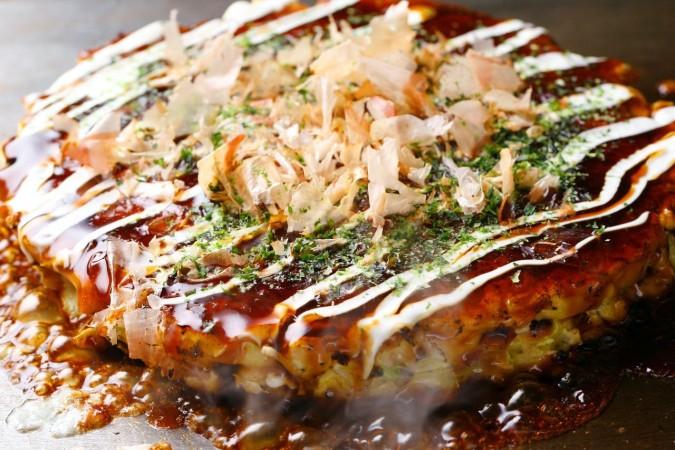
Okonomiyaki - © TokyoTreat
Festivals et Célébrations Locales
Festival des Fleurs d’Hiroshima
Le Festival des Fleurs d’Hiroshima est une célébration vibrante qui a lieu chaque année début mai. Cet événement transforme la ville en un spectacle floral coloré avec des défilés, des spectacles en direct et des activités sur le thème des fleurs. Les visiteurs peuvent profiter d'un large éventail de divertissements, notamment de la musique, des danses et des spécialités culinaires de rue, le tout dans un décor fleuri. Ce festival est une occasion joyeuse qui met en valeur l’esprit communautaire et l'amour de la nature à Hiroshima.
Festival des Feux d’Artifice sur l’Eau de Miyajima
Le Festival des Feux d’Artifice sur l’Eau de Miyajima est un événement spectaculaire qui se déroule en août sur l'île de Miyajima. Le festival présente un éblouissant feu d’artifice reflété dans les eaux entourant le sanctuaire d’Itsukushima. Le ciel nocturne s'illumine de couleurs éclatantes, créant une ambiance magique. Des stands de nourriture traditionnelle et des spectacles musicaux complètent l’expérience, rendant cet événement inoubliable pour les habitants et les visiteurs.
Festival des Carpes d’Hiroshima
Le Festival des Carpes d’Hiroshima, organisé pendant l'été, célèbre l'équipe de baseball emblématique de la ville, les Hiroshima Carp. Le festival comprend des défilés, des spectacles et diverses activités axées sur l’équipe et ses fans. C’est un événement dynamique qui met en lumière la culture sportive de Hiroshima et l’enthousiasme passionné pour les Carp, ajoutant une touche festive et énergique à l’été de la ville.
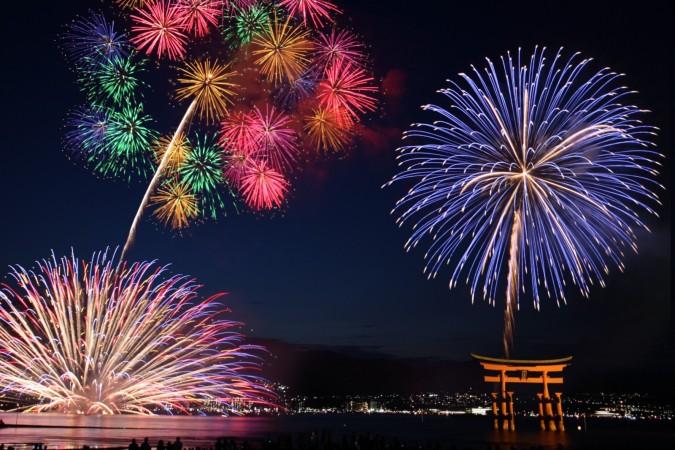
Festival des Feux d'Artifice de Miyajima - © Japan Web Magazine
Que Faire à Hiroshima
- Visitez le Parc du Mémorial de la Paix d’Hiroshima : Explorez le Parc du Mémorial de la Paix d’Hiroshima, un hommage émouvant aux victimes de la bombe atomique. Le parc comprend le célèbre Dôme de la Bombe Atomique, le Musée du Mémorial de la Paix et des monuments paisibles propices à la réflexion.
- Visitez le Sanctuaire d’Itsukushima : Faites une excursion vers le sanctuaire d’Itsukushima sur l'île de Miyajima, célèbre pour son torii "flottant" et ses vues spectaculaires sur la mer. Classé au patrimoine mondial de l'UNESCO, le sanctuaire offre également des sentiers de promenade pittoresques.
- Explorez le Château d’Hiroshima : Découvrez le Château d’Hiroshima, également connu sous le nom de Château des Carpes. Avec son architecture ancienne et ses jardins pittoresques, il offre un aperçu de l’histoire médiévale de la ville.
- Promenez-vous dans le Jardin Shukkeien : Détendez-vous dans le jardin Shukkeien, un jardin paysager historique avec des étangs paisibles, des maisons de thé traditionnelles et une flore saisonnière. C’est un lieu idéal pour une promenade tranquille et une pause contemplative.
- Croisières vers l’Île de Miyajima : Profitez d'une traversée en ferry vers l'île de Miyajima pour admirer des paysages magnifiques et explorer sa richesse culturelle. En plus du sanctuaire d’Itsukushima, l'île propose des sentiers de randonnée, des cerfs amicaux et de l'artisanat local.
- Découvrez les Marchés Locaux : Parcourez les marchés locaux de Hiroshima pour déguster des produits frais, des fruits de mer et des spécialités régionales. Ces marchés animés offrent un véritable aperçu de la scène culinaire de la ville.
- Participez à un Festival Local : Prenez part aux festivités d'un festival local, comme le Festival des Fleurs d’Hiroshima ou le Festival des Feux d’Artifice sur l’Eau de Miyajima. Ces événements présentent des défilés vibrants, des spectacles traditionnels et mettent en valeur la culture locale.
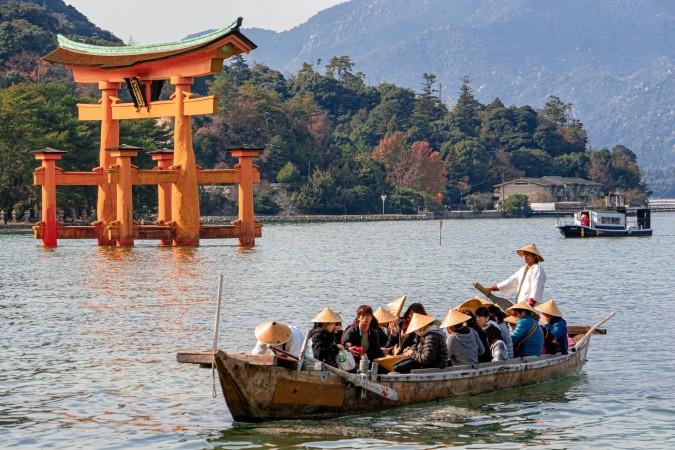
Visitez le torii "flottant" au sanctuaire Itsukushima - © Bing Hui Yau
Faire du Shopping à Hiroshima
Quartiers Commerçants Populaires
Hiroshima regorge de quartiers commerçants animés où les visiteurs peuvent trouver de tout, des boutiques de luxe aux marchés locaux. La galerie marchande Hondori est une rue piétonne animée bordée de magasins et de restaurants, idéale pour acheter des souvenirs et déguster des en-cas locaux. Hatchobori est un autre quartier prisé, offrant un mélange de magasins de mode, d'électronique et de boutiques spécialisées.
Souvenirs Locaux
Lors de votre shopping à Hiroshima, n’oubliez pas de rapporter des souvenirs locaux, notamment des objets d’artisanat traditionnel et des spécialités culinaires. Parmi les articles populaires figurent la sauce pour okonomiyaki à la mode de Hiroshima, des céramiques faites à la main et des confiseries locales. Ces souvenirs uniques reflètent l’essence de Hiroshima et constituent d’excellents cadeaux ou souvenirs personnels.
Marchés
Explorer les marchés de Hiroshima offre une expérience de shopping authentique. Le marché central de gros de Hiroshima propose un aperçu de la scène alimentaire locale, avec des produits frais, des fruits de mer et des articles artisanaux. Ces marchés sont des endroits parfaits pour découvrir la diversité culinaire de la ville et goûter aux saveurs locales.
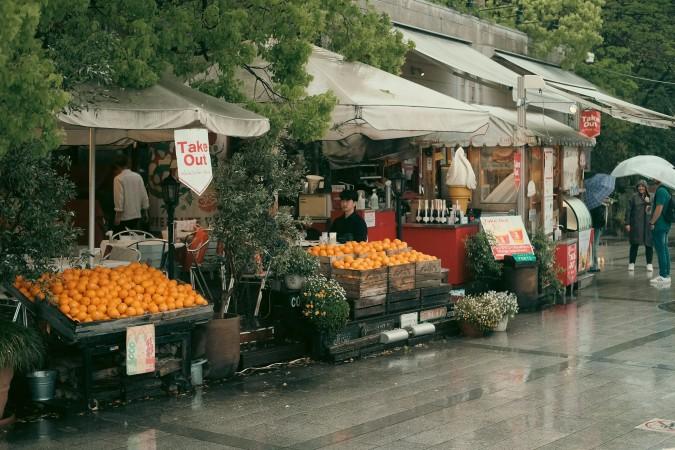
Se promener dans les rues à la recherche de souvenirs locaux - © Vladyslava Andriyenko
Climat à Hiroshima : Meilleure Période pour Visiter
Printemps à Hiroshima
- Climat : Le printemps est l'une des meilleures périodes pour visiter Hiroshima. Les températures douces oscillent entre 10 et 20 °C, avec une faible humidité, offrant des conditions agréables pour les visites touristiques.
- Tendance Touristique : Cette saison est célèbre pour ses cerisiers en fleurs, avec des sites emblématiques comme le Parc du Mémorial de la Paix et le Jardin Shukkeien offrant de magnifiques spectacles floraux. Les visiteurs affluent pour admirer ces fleurs et participer à des pique-niques hanami, une tradition locale appréciée.
Été à Hiroshima
- Climat : L'été à Hiroshima est chaud et humide, avec des températures atteignant souvent entre 27 et 35 °C.
- Tendance Touristique : Cette saison est animée par des festivals tels que le Festival des Fleurs d’Hiroshima, qui propose des défilés colorés et des performances culturelles. Malgré la chaleur, c’est aussi une excellente période pour visiter l'île de Miyajima, profiter des brises marines et assister au Festival des Feux d’Artifice sur l’Eau en août.
Automne à Hiroshima
- Climat : L'automne est une autre saison prisée, avec des températures fraîches et agréables entre 15 et 24 °C, idéales pour les activités de plein air.
- Tendance Touristique : Les couleurs d'automne sont particulièrement spectaculaires à des endroits comme le Jardin Shukkeien et le Château d’Hiroshima. Cette période est également marquée par divers festivals locaux célébrant les récoltes et les traditions culturelles, ajoutant encore au charme de la ville.
Hiver à Hiroshima
- Climat : L'hiver à Hiroshima est doux par rapport à d'autres régions du Japon, avec des températures allant de 5 à 10 °C. Le temps est généralement clair et sec.
- Tendance Touristique : Bien que la neige soit rare, les températures fraîches créent une atmosphère paisible idéale pour visiter les sites historiques et déguster des plats chauds comme le ramen à la mode de Hiroshima. L'hiver offre également une période plus calme pour découvrir les événements locaux et admirer les décorations festives de la ville.

L'automne à Hiroshima - © HONG FENG
Étiquette Culturelle à Hiroshima
- Usages Locaux et Manières : À Hiroshima, comme dans le reste du Japon, la politesse et le respect sont essentiels. Il est courant de faire une révérence pour saluer ou remercier quelqu'un. Les bonnes manières publiques sont très appréciées, il est donc conseillé de parler doucement et de garder son téléphone en mode silencieux dans les lieux publics.
- Étiquette à Table : Lors des repas, il est important d'utiliser correctement les baguettes et d'éviter de les enfoncer verticalement dans un bol de riz, car cela ressemble à une pratique funéraire. Il est respectueux de dire "Itadakimasu" avant de commencer à manger et "Gochisousama" après avoir terminé, pour exprimer votre gratitude envers votre hôte.
- Enlever ses Chaussures à l'Intérieur : Lorsque vous entrez dans une maison, un ryokan (auberge traditionnelle) ou certains restaurants, il est d'usage d'enlever ses chaussures et de les remplacer par des chaussons d'intérieur. Cette pratique permet de garder les espaces propres et est un signe de respect.
- Manipulation de l'Argent : Lors du paiement, il est poli de présenter l'argent au caissier avec les deux mains. Cela est perçu comme un geste de respect pour la transaction.
- Étiquette des Bains Publics : Lorsque vous utilisez des bains publics (onsen ou sento), il est nécessaire de se laver et de se rincer soigneusement avant d'entrer dans le bain commun. Il n'est pas permis de porter des maillots de bain et les conversations doivent être discrètes.
- Faire la Queue : Respectez la pratique locale de faire la queue de manière ordonnée aux arrêts de bus, dans les gares et les ascenseurs. Il est important de respecter la file d'attente et d'attendre son tour.
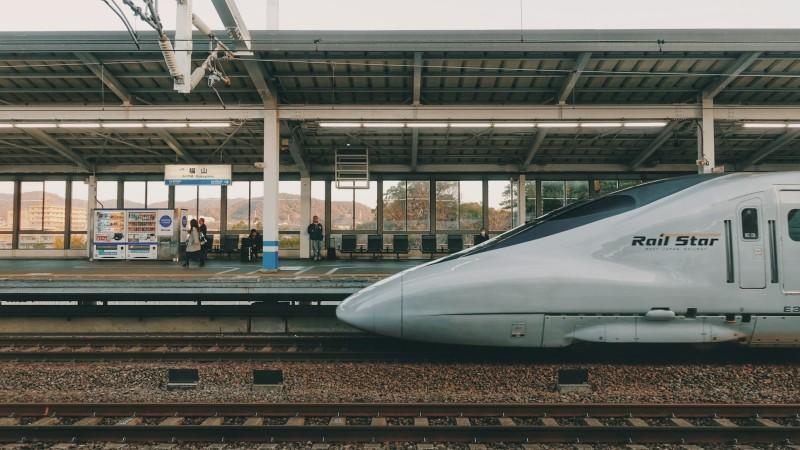
Gare Shinkansen de Hiroshima - © Aika Kohama
Informations Essentielles pour les Voyageurs
Se Déplacer à Hiroshima
Hiroshima dispose d'un système de transport public bien connecté, comprenant des tramways exploités par la Hiroshima Electric Railway (Hiroden), qui relient les principales zones de la ville et ses attractions, ainsi que des bus et des trains pour une couverture plus large et des connexions vers les villes voisines. Pour plus de flexibilité, les visiteurs peuvent louer un vélo ou une voiture, bien que les taxis soient également disponibles, mais peuvent être coûteux. L'utilisation d'applications de covoiturage ou la prise de taxis depuis des stations désignées est aussi courante. Pour simplifier les déplacements, il est recommandé de se procurer un Hiroshima Sightseeing Pass, qui offre un accès illimité aux transports en commun et des réductions dans diverses attractions locales.
Distributeurs Automatiques et Services Bancaires
Les distributeurs automatiques de billets (DAB) sont répartis de manière pratique dans toute la ville, y compris dans des magasins de proximité comme 7-Eleven et FamilyMart, ce qui permet d'accéder facilement à de l'argent liquide. Bien que les cartes de crédit et de débit internationales soient largement acceptées, il est conseillé de toujours avoir un peu d'argent liquide pour les achats plus petits. Pour les services bancaires, les principales banques de Hiroshima proposent une gamme de services, y compris des échanges de devises avec un taux de change clair et raisonnable.
Où Séjourner à Hiroshima
Hiroshima propose une grande variété d'options d'hébergement pour répondre à tous les goûts et budgets, allant des hôtels de luxe aux hôtels de catégorie moyenne, en passant par des maisons d'hôtes et des ryokans traditionnels, chacun offrant une expérience unique, allant des commodités modernes à l'hospitalité japonaise traditionnelle. Pour plus de commodité, il est idéal de séjourner dans le centre-ville d'Hiroshima, avec des quartiers comme le Nishi Ward et Hondori offrant un accès facile aux principales attractions, commerces et restaurants. Pour garantir les meilleures options, notamment pendant les périodes de pointe comme la saison des cerisiers en fleurs ou les festivals, il est conseillé de réserver à l'avance.
Des articles pour vous

Explore Fukushima - Japan Travel, Asia
Nestled in Japan's scenic Tohoku region, Fukushima offers travelers a unique blend of historical charm, cultural richness, and natural beauty. Known for its stunning landscapes and welcoming communities, Fukushima is an excellent destination for those seeking an authentic Japanese experience beyond the bustling metropolises. Renowned for its diverse attractions, from ancient castles and hot springs to vibrant festivals and picturesque countryside, Fukushima offers a great opportunity for cultural and historical exploration for anyone who loves Japanese culture.
Population: Approximately 1.8 million in 2023.
Economy: Specializing in the seafood and fishing industries, Fukushima, with its historical impacts, now continues to thrive as one of the most developed and largest economies in Japan.
Landmarks: Famous for Aizu-Wakamatsu Castle, Fukushima City Historical Museum, and Ouchi-juku.

La symphonie saisonnière de l'Inde : Révéler les meilleurs moments pour explorer le sous-continent
Les traditions anciennes dansent avec les merveilles modernes dans une terre où les épices et l'encens embaument l'air, et chaque recoin cache une histoire prête à être découverte. L'Inde, vaste et diverse, se déploie comme un monde miniature en soi. Mais quand devriez-vous entreprendre ce voyage épique ? Rejoignez-nous pour un tourbillon à travers la tapisserie saisonnière de l'Inde et trouvez le moment parfait pour votre aventure.

Voyage culinaire à travers la Chine : Savourez les saveurs diversifiées
Des rives subtropicales de Canton aux steppes balayées par le vent du Xinjiang, le vaste paysage de la Chine est une tapisserie de saveurs, chaque région mettant en avant ses propres trésors culinaires. Avec plus de 2000 miles séparant les palais de dim sum du sud des étals de kebabs du nord-ouest, et des woks crépitants entre les deux, la diversité gastronomique de la Chine est véritablement inégalée. Alors, prenez vos baguettes et embarquez pour une aventure gourmande à travers les plats les plus délicieux du Royaume du Milieu !

Vivez l'expérience à bord du RV Indochine II - Une croisière sur le Mékong
Le RV Indochine II est un navire de croisière fluviale de luxe, offrant un voyage inoubliable à travers de nombreuses attractions le long du fleuve Mékong. Construit en 2017, ce vaisseau haut de gamme allie élégance coloniale et commodités modernes pour créer un environnement à la fois confortable et élégant pour son équipage et ses passagers. La taille intime du navire en fait le choix idéal pour ceux qui recherchent une expérience de croisière plus personnelle tout en explorant la culture, les paysages et le patrimoine riches du Vietnam et du Cambodge. Que vous admiriez le paysage depuis votre balcon privé ou que vous dégustiez une cuisine locale authentique, le RV Indochine II promet une aventure exotique hors du commun.

Assistez à la pêche sur pilotis au Sri Lanka
Le Sri Lanka, réputé pour ses plages magnifiques et son riche patrimoine culturel, abrite une tradition unique qui captive les voyageurs depuis des siècles : la pêche sur pilotis. Cette pratique ancienne, transmise de génération en génération au sein des communautés côtières, allie art et nécessité, offrant un aperçu d'un mode de vie intimement lié aux rythmes côtiers de l'île. La pêche sur pilotis au Sri Lanka n'est pas simplement un moyen de capturer des poissons ; c'est un emblème culturel, incarnant la résilience et l'ingéniosité des communautés de pêcheurs sri-lankaises.

À l'assaut des sommets : guide du randonneur de l'Himalaya
Lorsque les premiers rayons du soleil teintent les sommets enneigés de doré et de rose, vous êtes au seuil de l'aventure. Bienvenue dans l'Himalaya, où chaque pas est une immersion dans le plus grand spectacle de la nature. Avec Tweet World Travel comme guide, préparez-vous à un trek d’aventures, qui éveillera vos sens et vous transformera à jamais.
